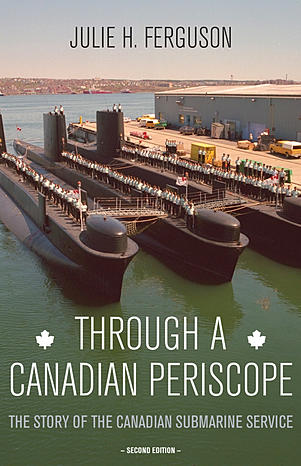Through a Canadian Periscope: The Story of the Canadian Submarine Service
by Julie H. Ferguson Dundurn 2014 ISBN 9781459710559
Julie Ferguson, a well known figure in the west coast writing community, has done an excellent job updating her first edition of this book to coincide with the 2014 Canadian Submarine Centennial.The well written text brings to life what deplorable conditions onboard most submarines, until recent years, with little or know sanitation, privacy or personal hygiene possible. The first Canadian submarines were bought by the British Columbia Government in 1914 to reassure local citizenry that they were safe in spite of no credible defences from marauding German cruisers. The reader can really appreciate the hardships of serving on these early vessels, originally ordered in Seattle by the Chilean Navy.Two submarines were obtained from the UK after the First World War which were soon retired from service with Ottawa unwilling to spend on defence. Much of the book details the experiences of Canadian officers serving in the Royal Navy submarine arm, the only time Canadian submariners experienced combat.In the Second World War, Canada lacked any submarines and soon learned they were desperately needed for antisubmarine warfare (ASW) training and eventually convinced the Royal Navy to base training submarines in Newfoundland, Nova Scotia and Bermuda. Postwar, the Royal Canadian Navy financed the basing of the Royal Navy Sixth Submarine Squadron in Halifax for ASW training. This arrangement was never quite satisfactory and Canada eventually began to pursue their own boats.These early efforts, much like acquisition projects of today, were victims of either bureaucratic bungling or a naval leadership afraid to speak up. Two former radar picket submarines from the US Navy were earmarked for sale to Canada from their reserve fleet, USS Burrfish and Tigrone. The former was successfully purchased and assigned for ASW training at Esquimalt in 1961 and the latter, intended for Halifax, fell through by ineptitude in Ottawa by naval leadership. (Ironically, USS Tigrone visited Halifax after participating in a 1970 ASW exercise.)By 1970, three obsolete Oberon Class submarines were built in the UK and another was obtained to replace Grilse on the West Coast. The boat obtained, USS Argonaut, had just finished a four year assignment in the Mediterranean was actually in worse shape than Grilse.And therein lies the problem with Canada even having submarines. Naval leadership still plans and trains to refight the Battle of the Atlantic from the First and Second World War. Submarines are intended for ASW training and are never employed in an operational role. Submarine officers had great difficulty passing the multinational commanding officer course, known as Perisher, as they only been operating in support of training surface ships.When the four Upholder Class submarines were obtained from the UK in 1998 after a number of years dithering over it, the first thing Canada did was removed two thirds of their weapon capability, meaning they can no longer fire missiles or lay mines. Back to ASW training.A few small errors noted in the text:
- Russian submarines built in the First World War in BC were constructed in Burnaby and Vancouver and were disassembled for ease of shipment. The latter batch were completed after the Russian Revolution and were sold to the US Navy, which commissioned them in Bremerton.
- In 1939, Canada did not declare war until September 10th.
- In 1944, Newfoundland was a British Crown Colony and not part of Canada. In fact, service personnel from Canada based in Newfoundland were awarded overseas benefits by Veteran's Affairs.
- When boarding a naval ship, you enter at the brow, not the bow.
- HMCS Rainbow listed as SS7S instead of SS 75.


